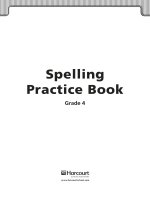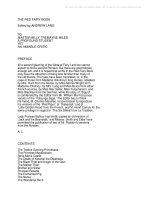Baltimore book culture
Bạn đang xem bản rút gọn của tài liệu. Xem và tải ngay bản đầy đủ của tài liệu tại đây (81.65 KB, 15 trang )
chapter 3
Baltimore book culture
Read, at a stall (for oft one pops
On something at these stalls and shops,
That does to quote, and gives one's Book
A classical and knowing look. ±
Indeed I've found, in Latin, lately,
A course of stalls improves me greatly)
± Thomas Moore, ``The Fudge Family in Paris''
In mid-1829, a time after he had received his discharge from the
army yet before he had been accepted to West Point, Edgar Allan
Poe was living in Baltimore with virtually no money and little else
but the clothes on his back. In the second week of August he wrote
to John Allan with a request: ``I left behind me in Richmond a small
trunk containing books and some letters ± will you forward it on to
Baltimore to the care of H-W. Bool Jr and if you think I may ask so
much perhaps you will put in it for me some few clothes as I am
nearly without.'' Henry W. Bool, Jr., was a book dealer who had
been living and working in Baltimore for many years. A mutual
acquaintance recalled, ``He was a Northern man, and settled in
Baltimore in the capacity of vendor of second-hand books. His
magasin was a cellar, and his assortment of mutilated tomes elicited
much attention on the part of the antiquarian book-worm.''
1
Since coming to Baltimore in or before 1820, Bool had actively
engaged in many aspects of the book trade. He had served as a
subscription book agent, book auctioneer, proprietor of the Cheap
Book Store, proprietor of the Repository of Cheap Books, and new
book auction and commission merchant.
2
The year Poe came to
know him he tried his hand at publishing with The Patriotic Sailor:
Or, Sketches of the Humors, Cares, and Adventures of a Naval Life,an
anonymous, two-volume sea novel published at Bool's ``Cheap
Repository, No. 60 Baltimore Street,'' which may have partially
30
inspired Poe's Narrative of Arthur Gordon Pym. Bool's ``eccentricities
made him a noted character,'' and his Baltimore Street salesroom
developed a reputation as ``the lounging place of all the wags in the
city'' where many ``humorous scenes took place.''
3
There can be
little doubt that the opportunity to read, loiter, and discuss books
attracted Poe during his drifter's days, but the bookish opportunities
Bool offered may not have been the only or even the primary reason
Poe made his acquaintance, for, among his other business ventures,
Bool also ran an intelligence of®ce, the nineteenth-century equiva-
lent of the modern-day employment agency. Poe was looking for a
job.
No documentary evidence survives to show whether or not Henry
Bool found Poe a job in 1829, but his decade-long experience in the
book business allowed him to give Poe valuable advice for later use.
Within a year, Poe had reached West Point, and within another year
after that he had been court-martialed and dismissed. Before
leaving, however, Poe solicited enough subscriptions among the
cadets to ®nance Poems, his third collection of verse. Bool's experi-
ence as a subscription book agent offered Poe the know-how for
publishing Poems by subscription, which, after all, was really quite
shrewd. At the time, anyone publishing a book by subscription
generally had to pay a percentage to the agent who solicited the
subscriptions and another percentage to the one who collected the
money.
4
Poe avoided the ®rst by soliciting subscriptions himself, and
he avoided the second by having the US Army collect the money for
him. In the ®rst half of 1831, Poe returned to Baltimore. He moved
in with his paternal aunt, Maria Clemm, and her daughter Virginia.
He likely recontacted Henry Bool, still doing business at 60 Balti-
moreStreet,forPoeoncemoreneededajobandaplacetoread
and loiter.
Bool's, of course, was not the only place a young man who took an
interest in literature could while away time in Baltimore during the
early 1830s. Far from it. Baltimore had a lively book culture and
many bookdealers. Edward J. Coale, for instance, had been retailing
books in Baltimore for over two decades, and his store on Calvert
Street has long been considered one of Poe's haunts.
5
Another
acquaintance of Poe's remembered Coale for his kindness, his
usefulness, and his good heart.
6
The fact that Poe had his manuscript
volume of tales ®nely bound for the Saturday Visiter contest suggests
that his contacts among Baltimore bookmen extended to book-
Baltimore book culture 31
binders as well, including one who was friendly enough to bind a
manuscript volume gratis.
Bookdealers less accommodating than Bool or less kind-hearted
than Coale may have been reluctant to allow a down-and-out young
man to dawdle within their doors for long periods of time, but some
contemporary booksellers offered an economical alternative to
purchasing books: the circulating library. Many dealers kept a shelf
or two of books from which customers could borrow volumes for as
little as a few pennies a week. While most circulating libraries
consisted of little else but popular sentimental novels, some book-
sellers allowed regular stock that did not sell readily to be circulated.
Others brought the circulating library to a new level of sophistica-
tion. None were more successful in Baltimore than the printer±
bookseller Joseph Robinson who had opened a circulating library by
1812 and literary rooms a half-dozen years later. The establishment
contained four rooms. Two were downstairs: the book delivery
room, which also served as the reception area, and the ladies'
reading room, which contained reading tables, writing desks, and a
pianoforte. The two upstairs rooms were for the men, a quiet room
for study and book-reading and another for conversation and
newspaper-reading. Distinguishing book-reading from newspaper-
reading and associating newspaper-reading with conversation, the
arrangement of Robinson's literary rooms provides an important
insight into the reading process during the early nineteenth century.
Access to such luxurious reading opportunities had a price, however.
Library privileges at Robinson's cost six dollars a year and access to
his literary rooms four dollars more. Poe may have never seen the
inside of Robinson's circulating library, his poverty relegating him to
those which charged by the book.
7
The circulating libraries were commercial ventures, but Poe's
Baltimore had other libraries which were social undertakings. To
form these social libraries, groups of like-minded men and, occasion-
ally, a few women would subscribe or, in other words, purchase
shares entitling them to borrow volumes from the collection and to
help decide which volumes the library would contain. Benjamin
Franklin, who had given these library companies their start a
hundred years before, retold the story in his Autobiography,copiesof
which were ubiquitous in Poe's time.
8
After the communal library
planned by the members of Franklin's junto failed, Franklin and his
friends formed the Library Company of Philadelphia in 1731, the
32 Poe and the printed word
``Mother of all the North American Subscription Libraries,'' as he
later called it.
9
Over the next century, the social or subscription
library ¯ourished. At ®rst, only well-to-do gentlemen could afford to
subscribe to the library companies, but by the early nineteenth
century, groups of other like-minded people began forming social
libraries often named for the shared interests of their subscribers.
Mercantile and mechanics' libraries ¯ourished. Baltimore had at
least two subscription libraries during the early 1830s: the Library
Company of Baltimore and the Apprentices' Library.
First established in 1795, the Library Company of Baltimore
attracted the city's gentlemen, members of the professional classes,
and successful merchants who were willing and able to purchase a
share in the company and pay annual dues. At the time Poe lived in
Baltimore, shares cost ®fty dollars and annual fees ®ve or ten dollars.
Poe could not have afforded to join the Library Company of
Baltimore, but his second cousin Neilson Poe was a member when
Poe came to Baltimore, and would have been able, though not
necessarily willing, to withdraw books for Edgar Poe's use.
10
The
®nest library in the city, the Library Company of Baltimore had a
diverse collection which included theology and ecclesiastical history;
moral philosophy; arts and sciences; law and politics; trade and
commerce; history and biography; voyages and travels; and a good
belletristic collection containing such important aesthetic works as
Isaac Disraeli's Essay on the Manners and Genius of Literary Characters,
Alexander Gerard's Essay on Taste as well as his Essay on Genius,
William Smith's edition of Longinus, Lord Kames's Elements of
Criticism, and Madame de Stael's In¯uence of Literature upon Society as
well as her Germany, being Essays upon the Manners and Literature of the
Germans. Poetry titles included Wordsworth's and Coleridge's Lyrical
Ballads andLordByron'sChilde Harold, Corsair,andEnglish Bards and
Scotch Reviewers, a satire Poe found coarse and malignant.
11
When (or if ) Neilson Poe was unwilling to borrow books for his
cousin and when Edgar Poe lacked even the few pennies needed to
borrow books from the circulating libraries, his only recourse was to
return to those bookstores run by men like Bool and Coale who did
not mind someone hanging around, reading and not spending
money. Though Poe was a little out at the sleeves, he was no derelict.
After all, he had already published three collections of verse. His
volumes of poetry had not gained him the notoriety he had hoped
for, but he could use their publication to reassure bookdealers that
Baltimore book culture 33
he was a serious writer, not just some vagrant seeking refuge from
the cold.
At the new bookstores, Poe could have found a wide variety of
books for sale. Besides the staples of the book trade ± almanacs,
spelling books, songbooks, conduct books, chapbooks, psalters, and
catechisms ± the Baltimore press issued numerous other books
during the early 1830s. Giftbooks, including N. C. Brooks's The
Amethyst, were becoming increasingly popular. Brooks devoted much
effort to enhancing Baltimore's literary reputation, and he would
become an associate of Poe's.
12
Giftbooks would become an
important outlet for Poe's ®ction. Some of his ®nest tales ``William
Wilson,'' ``The Pit and the Pendulum,'' ``The Purloined Letter'' ±
would appear in giftbooks. His ``Siope ± A Fable'' would appear in a
local one, The Baltimore Book.
13
Yet another edition of William Wirt's
Letters of the British Spy appeared in 1831. English translations of
Plutarch's Lives and Josephus' Works were also published in Baltimore
during the early 1830s. Several editions of Baron Munchausen's
Travels and Adventures appeared, too. Books about the American West
were gaining more attention. Mary Austin Holley's Texas,awork
promoting Western emigration, and Philip L. Edwards's Rocky
Mountain Correspondence, a travelogue, were both published in Balti-
more. Frederick Marryat's Peter Simple: Or, Adventures of a Midshipman
was reprinted in Baltimore in 1833. Though Poe disliked Marryat's
work generally, he found ``truthfulness, naturalness, and bonhommie''
in Peter Simple and asserted that ``no better nautical adventures are to
be met with than we ®nd in this the best of his novels.''
14
Other
®ction reprinted in Baltimore he found less agreeable. In 1834,
Joseph Robinson reprinted William Beckford's Vathek, a work Poe
called a ``heterogenous, tumid, and blasphemous piece of East-
ernism.''
15
Besides the Baltimore imprints, the new bookstores would have
stocked the latest publications from Boston, New York, and Philadel-
phia. Works published during the 1831±1834 period which Poe
became familiar with include three by William Gilmore Simms:
Atalantis: A Story of the Sea; Martin Faber: The Story of a Criminal;andGuy
Rivers: A Tale of Georgia.
16
Seba Smith's Life and Writings of Major Jack
Downing of Downingsville Away Down East in the State of Maine,awork
Poe characterized as ``coarse, but full of fun, wit, sarcasm, and
sense,'' was also available.
17
A Philadelphia edition of Mary Shelley's
Frankenstein appeared in 1833. Horace Wemyss Smith recalled Poe
34 Poe and the printed word
reading the work in Philadelphia some years later, which must be
taken with some skepticism, for Smith's recollection is almost too
good to be true. As he remembered it, Poe read Frankenstein while
seated in the doorway of the Smith family mausoleum.
18
Edward
Bulwer-Lytton's Eugene Aram and his The Pilgrims of the Rhine were
reprinted in the United States during the early 1830s. Frances
Trollope's often derogatory Domestic Manners of the Americans appeared
around this time: a work that met with great disfavor among
American readers who, as Poe recorded, joked that the book might
have been better titled Manners of the American Domestics.
19
Several
works in¯uencing Poe's critical outlook were reprinted in the United
States during the early 1830s: Charles Lamb's Last Essays of Elia,
James Montgomery's Lectures on General Literature, and, most impor-
tantly, John Black's English translation of August Wilhelm von
Schlegel's Course of Lectures on Dramatic Art and Literature, reprinted in
Philadelphia in 1833. Some London imports were also available such
as Thomas Carlyle's Sartor Resartus, a work Poe did not greatly
appreciate. He later commented, ``We will venture to bet that the
meaning (if there be any) of the Sartor Resartus has only the two
faults of the steed in Joe Miller. In the ®rst place, it is hard to catch.
In the second place it is worth nothing when caught.''
20
Personal contacts gave Poe further opportunity to become part of
Baltimore book culture. To understand Baltimore's literary elite in
Poe's day, we need to go back a decade and a half to mid-1816 when
a group of professional men, mainly attorneys and physicians, many
of whom were veterans of the War of 1812, gathered to form the
Delphian Club, a literary coterie named after the oracle at Delphi
and reminiscent of a similar gathering of Maryland's men of letters
the century before, the Tuesday Club. Membership, the founders
decided, would be limited to nine at any given time, allowing each to
consort with a different muse. Its members included John Neal
before he left Baltimore to sojourn in England and eventually to
settle in Maine; William Gwynn, an old bachelor who ``enjoyed a
bottle of good wine with as much gusto as did John Falstaff his sack,''
characteristically sported ``a high white cravat'' with ``his hair done
up in a queue,'' and became the club's last president in 1824; and
John H. B. Latrobe, the last member to join the club before it
dissolved.
21
All members received club names. Neal, whose most
famous written work was a poem on Niagara Falls, was known as
Baltimore book culture 35









![Brook-Hart - Business Benchmark Advanced - Student''''s Book [ESL English] (Cambridge, 2007)(AnswerKey)](https://media.store123doc.com/images/document/13/to/zu/medium_92z3Htlnzt.jpg)